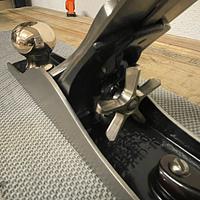Share your craft projects
Make new craft buddies
Ask craft questions
Blog your craft journey

DevinT
2746 posts
and
20 followers
in about 3 years
in about 3 years
MacBeath #2: White Wenge
This is
part 2
in a
3 part
series:
MacBeath
-
Introduction
-
White Wenge
-
Red Zebrawood
- Introduction
- White Wenge
- Red Zebrawood
Not a typo. White Wenge. Arrived about 3 weeks ago
15 Comments
another i never heard of ?
working with my hands is a joy,it gives me a sense of fulfillment,somthing so many seek and so few find.-SAM MALOOF.
Me too. Never heard of it. They only have it in 8/4 — now this I got to see. Might have to pick some up for a special occasion too
$6.70 a board foot? That’s only $1.32 more than 8/4 Poplar! This white Wenge is $0.52 cheaper than 8/4 Cherry!
nice looking wood !
working with my hands is a joy,it gives me a sense of fulfillment,somthing so many seek and so few find.-SAM MALOOF.
Only wood I [now] know that can be a contrast with itself when paired with regular Wenge!
I'm getting splinters in my fingers just looking at it!
The Other Steven
well white wenge is not a mistake.
working with my hands is a joy,it gives me a sense of fulfillment,somthing so many seek and so few find.-SAM MALOOF.
So I had to look it up.
It’s not Wenge, it’s Lati.
It’s not Wenge, it’s Lati.
Botanically, lati and wenge aren’t closely related, and occur in two separate genera, Amphimas and Millettia, respectively.
$5/bf. for 8/4 Poplar? Yikes!
Last time I bought any (5+ years ago) it was about $2/bf.
That "wenge" is really cool! Wonder how it would react to fuming or whatever would leave the flecks white and darken the rest?
Last time I bought any (5+ years ago) it was about $2/bf.
That "wenge" is really cool! Wonder how it would react to fuming or whatever would leave the flecks white and darken the rest?
I don’t know, got any tips for a novice at fuming? Where to start? I am familiar with the idea, as Gustav Stickley used ammonia fuming of his Oak chairs, but have not heard or read about how to do it in a modern setting
I've written a fair amount about it, basically you have a method to contain the fumes and your project, then add a bowl of ammonia and let the fumes take over.
You do need strong (10%) ammonia or it'll take a week.
You do need strong (10%) ammonia or it'll take a week.
You say “or it will take a week” but how long should one expect 10% to take before peak results are achieved?
Depends on the look you are after (check every few hours), but I can usually turn white oak that has good tannin into a nice coffee brown after about 8 hours.
You can test a spot for tannin content with a drop of ammonia (any kind) or a drop of iron acetate (steel wood dissolved in white vinegar).
My small tables were my most recent fumings.
You can test a spot for tannin content with a drop of ammonia (any kind) or a drop of iron acetate (steel wood dissolved in white vinegar).
My small tables were my most recent fumings.
Mr. Rick did a post with lots of useful commentary for just that.
The adding of tannins works, but has side effects depending on the solution you use in application.
Alcohol would minimize any after sanding, water would raise the grain.
Fuming can go really deep which I like because it allows for post darkened woods to be sanded.
Of course for coloring there is the need for tannins in the wood (natural or added) and something to react with (ammonia, iron acetate, etc)
What I like (and wonder if the white wenge can replicate) is how the ray flecks in white oak have minimal tannins so that fuming will leave these alone while darkening the rest of the wood. Makes for some really popping contrast.
Your wenge has some nice flecks, but no idea if they would react like white oak.
The adding of tannins works, but has side effects depending on the solution you use in application.
Alcohol would minimize any after sanding, water would raise the grain.
Fuming can go really deep which I like because it allows for post darkened woods to be sanded.
Of course for coloring there is the need for tannins in the wood (natural or added) and something to react with (ammonia, iron acetate, etc)
What I like (and wonder if the white wenge can replicate) is how the ray flecks in white oak have minimal tannins so that fuming will leave these alone while darkening the rest of the wood. Makes for some really popping contrast.
Your wenge has some nice flecks, but no idea if they would react like white oak.


















